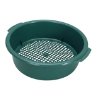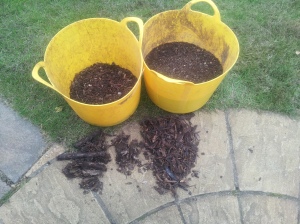Many people will just use compost ‘as it comes’ from the compost bin by digging it in to the soil around plants or into the vegetable patch.
Sometimes it is preferable to have fine compost for use in potting up seedlings or as I often do, use as a lawn top-dressing (it does wonders to reduce moss!) but large pieces of compost are hard to rake in and can cover the grass and act as ‘mulch’ – not the desired result.
I have tested a few compost sieves and I thought it was time to summarise how they perform and offer a view on the how worthwhile compost sieving is.
Sieving compost can be tricky and labour intensive – it does not take too many lumps of wet moist compost to clog up the sieves.
The Plastic Hand Sieve
A Plastic hand sieve will cost £4-10. These work OK if you just have a bucket of compost to sieve. When you only have small amounts of compost, the price/performance is hard to beat. However, once you start to get into bags or wheel barrow loads; the hand sieves becomes far to time consuming and difficult. Most of us will just end up with aching arms and a stiff back! The plastic pan sieves struggle with moist compost – it will just roll into balls that won’t sieve. (There are a whole range of metal hand sieves that work the same as the plastic but cost a lot more).
The Rotary Sieve
The Rotary sieve cost approximately between £30-40. Now it is OK with dry compost and handles typical loads/sizes from the HOTBIN. However it tends to clog up when used with moist compost. Some large pieces can jam and you’ll need to stop and clear them before carrying on. (NB this review was based on third-party input not our own test).
The Watford Sifter
The Watford Sifter costs approx £120-150. It definitely works better with soil than compost. It did struggle with wet compost as it tends to clog and stick in centre of sieve and it did not tip ‘up and down’ far enough to move it from this position. Good for medium or large loads and certainly a good option if you have lots of soil and compost to sieve otherwise you might struggle to justify the cost.
Likes / dislikes:
- You get two screens – fine and coarse.
- Easy to push ‘up and down’
- A bit of a ‘pain’ to get the retained coarse material out of the sieve tray. In the end, I was continually lifting the whole box and tipping it out. It’s a heavy lift when not much is sieved. This issue goes away if most of the soil/compost gets sieved through – but if it is all fine in the first place there is no need to sieve!
The Scheppach Sieve
The Scheppach costs in the region of £350-400, this has to be a serious piece of kit. It is a trommel design (rotating cylinder) and uses and an electric motor to turn it so it also needs an electrical supply! It will handle significant volumes of soil and compost. We have not used this kit, but we know three large-scale gardeners/composters who do and they all rate it highly. If you are only using it 1-3 times a year, our opinion is it is questionable how much value you will actually get. Probably one for the professional and/or allotment/community schemes where you can share it. PS: It also takes a lot storage space.
The Compost Sifter
Compost Sifter costs £155 (excl £40 delivery to UK). This is very new and comes from Belgium. It uses a similar rotary tunnel (trommel) design as the Scheppach – but it is turned manually via a handle. By long way, it required the least effort and sieved more faster. The mesh (hole size) is smaller than the others (8mm) and this means it won’t sieve wet compost (based on our test of HOTBIN compost). However, after initial disappoint with wet compost, it absolutely cleaned up when it came to dry compost. Our current favourite – we may even resell it with a special HOTBIN specific tweaks!!
Likes / dislikes:
- Ease of turning – real winning feature
- Retains oversize and easy to get it out via panel that detaches
- It is very heavy – fine once set up on wheels, but you may need 2-people to get it out of box and set up on the frame.
- It still struggles with wet sticky compost – but so do all the rest!
Summary
Sieving compost can be tricky and labour intensive, especially if it is wet and sticky as it tends ball into large lumps and clog sieves.
After numerous tests on HOTBIN compost, we think we are on solid ground to say if you want to sieve the naturally sticky wet HOTBIN compost you will have to dry it first (see how below). All the sieves will perform significantly better with dried compost.
Our next question is: Is it worth sieving compost?
This is not just about the cost of the sieve and the time and effort that goes into sieving. The most beneficial part of compost is the group of humeric substances. These compounds impact soil fertility as they enhance root uptake of minerals and water. It therefore follows the biggest benefit comes from digging humeric substances into the root zone. If digging in, one has to question if the effort to sieve out any big bits. Large over sized lumps will compost down in soil over 12-24 months. As long as the total volume of large pieces is low, the ongoing composting of these pieces is unlikely to affect nitrogen availability during the final composting period. With HOTBIN compost there is always about 10-15% of small 0.5-1.5cm wood chip (bulking agent) pieces that remain in the compost. Our tests show these pieces are covered in layers of humeric compounds. We believe these pieces of wood chip are slowly composted as they are coated and protected from rapid decay. Whilst in the soil, small pieces of wood chip also aid aeration and soil tiling.
There are applications where sieved compost is useful e.g. when used as a lawn top-dressing (i.e. raking in a thin layer of compost on to the grass), or when creating a potting mix for seedlings. Lawn care is a huge part of British gardening. I personally have seen good results from top-dressing moss ridden lawns (high clay, poor drainage) with sieved compost. For those of you that want to drop dress, the method is outlined below.
In summary, for most compost users and most types of compost application, we do not believe drying compost and then sieving is worthwhile.
Compost and lawn top dressing
- In late Autumn take out your HOTBIN compost and dry it (we spread it out as a thin layer on patio / large sheet polyethylene)
- Add dried compost to compost sifter or like to sieve
- Sieve and bag up
- Spread on grass and rake out to about 1cm layer.
This will take huge quantities of compost – but the rewards is you won’t be spending much on lawn fertiliser or moss killer!













My husband made a frame from scrap wood and attached a fine mesh metal fencing material. This fits perfectly over my wheelbarrow. I take several shovels full of my compost, dump it over the frame and by hand I rub it through the mesh. What doesn’t go through the mesh becomes the start of my next compost pile. Still labour intensive but the cost was only about $3.00 for the mesh and the end product is already in my wheelbarrow, ready to be spread.
Sounds good, we will set up same option and give it a try
Pingback: Compost – Looks can be deceptive! | hotbincomposting
Pingback: Hotbin Composting Blog | Compost – Looks can be deceptive!